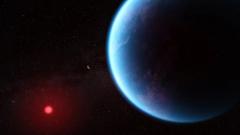#### A team from Cambridge University has discovered signals in the atmosphere of K2-18b that hint at the possible presence of life, although more analysis is required for confirmation.
### Exciting New Evidence Points to Potential Life on Distant Exoplanet K2-18b

### Exciting New Evidence Points to Potential Life on Distant Exoplanet K2-18b
#### Cambridge Researchers Unveil Genome-related Signals from Distant World Using James Webb Telescope
In a groundbreaking study, scientists from Cambridge University have reported promising evidence that the distant planet K2-18b may harbor life. The research team, utilizing data from NASA's James Webb Space Telescope (JWST), has identified molecules in the planet's atmosphere that are typically associated with biological activity on Earth. This revelation marks the second notable detection of life-related chemicals in K2-18b, amplifying the excitement surrounding this distant exoplanet.
Lead researcher Professor Nikku Madhusudhan explains that analysis of the planet's atmosphere has yielded the presence of key molecules, dimethyl sulphide (DMS) and dimethyl disulphide (DMDS). On Earth, these gases are produced primarily by marine phytoplankton and bacteria. Despite the compelling findings, the research community remains cautious, emphasizing the need for further validation. "This is the strongest evidence yet there is possibly life out there," said Madhusudhan. "I can realistically say that we can confirm this signal within one to two years."
K2-18b stands out due to its size, being roughly 2.5 times larger than Earth and situated approximately seven hundred trillion miles away from our planet. The JWST's advanced capabilities allow it to analyze the chemical makeup of the atmospheres of distant worlds based on the light passing through these atmospheric layers. The findings suggest that the concentration of DMS detected is extraordinarily high, thousands of times greater than levels found on Earth.
However, the research team acknowledges that the current detection is not definitive—scientists require about 99.99999% certainty (a five-sigma result) to claim a discovery, and the current results only reach three sigma, or 99.7% certainty. The previous detection gained only one sigma, which was met with skepticism.
Despite the excitement, independent scientists, including Edinburgh's Astronomer Royal Professor Catherine Heymans, note that confirming biological origins will remain a challenge. "Even with perfect data, we can't say for sure if this is of a biological origin,” she stated, cautioning that alternative geological processes could produce such molecules as well.
The debate over K2-18b continues as different teams propose varying theories about the planet's composition. Some believe it may be surrounded by a vast liquid ocean—evidenced by the absence of ammonia in its atmosphere—while others suggest it could be a molten rock world or a mini gas giant without a surface.
Professor Madhusudhan's group is collaborating with various research teams to explore non-biological sources for the detected gases, illuminating the scientific rigor surrounding these exploratory findings. "Everything we know about planets orbiting other stars comes from extremely faint signals," emphasized Professor Oliver Shorttle from Cambridge.
As the research progresses, Madhusudhan remains optimistic. "Decades from now, we may look back at this point in time and recognize it as when the living universe came within reach," he said. The study is documented in The Astrophysical Journal Letters, underscoring the ongoing quest to answer one of humanity's fundamental questions: are we alone in the universe?
Lead researcher Professor Nikku Madhusudhan explains that analysis of the planet's atmosphere has yielded the presence of key molecules, dimethyl sulphide (DMS) and dimethyl disulphide (DMDS). On Earth, these gases are produced primarily by marine phytoplankton and bacteria. Despite the compelling findings, the research community remains cautious, emphasizing the need for further validation. "This is the strongest evidence yet there is possibly life out there," said Madhusudhan. "I can realistically say that we can confirm this signal within one to two years."
K2-18b stands out due to its size, being roughly 2.5 times larger than Earth and situated approximately seven hundred trillion miles away from our planet. The JWST's advanced capabilities allow it to analyze the chemical makeup of the atmospheres of distant worlds based on the light passing through these atmospheric layers. The findings suggest that the concentration of DMS detected is extraordinarily high, thousands of times greater than levels found on Earth.
However, the research team acknowledges that the current detection is not definitive—scientists require about 99.99999% certainty (a five-sigma result) to claim a discovery, and the current results only reach three sigma, or 99.7% certainty. The previous detection gained only one sigma, which was met with skepticism.
Despite the excitement, independent scientists, including Edinburgh's Astronomer Royal Professor Catherine Heymans, note that confirming biological origins will remain a challenge. "Even with perfect data, we can't say for sure if this is of a biological origin,” she stated, cautioning that alternative geological processes could produce such molecules as well.
The debate over K2-18b continues as different teams propose varying theories about the planet's composition. Some believe it may be surrounded by a vast liquid ocean—evidenced by the absence of ammonia in its atmosphere—while others suggest it could be a molten rock world or a mini gas giant without a surface.
Professor Madhusudhan's group is collaborating with various research teams to explore non-biological sources for the detected gases, illuminating the scientific rigor surrounding these exploratory findings. "Everything we know about planets orbiting other stars comes from extremely faint signals," emphasized Professor Oliver Shorttle from Cambridge.
As the research progresses, Madhusudhan remains optimistic. "Decades from now, we may look back at this point in time and recognize it as when the living universe came within reach," he said. The study is documented in The Astrophysical Journal Letters, underscoring the ongoing quest to answer one of humanity's fundamental questions: are we alone in the universe?








